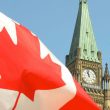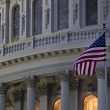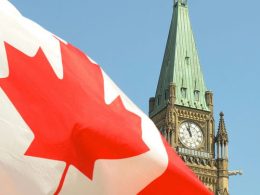by Hubert Marleau, Market Economist, Palos Management
Last week, I wrote that: “Trade wars and the end of U.S. exceptionalism crashed global growth expectations and hopes for lower inflation. Indeed, the OECD has warned that the trade war is taking a significant toll on the global economy, reducing its world growth forecast to 2.3% this year, well below trend and down from 2.9% last year, and to 2.2% in 2026, with a serious downside scenario if retaliatory trade barriers between countries become the norm. Indeed, the footings supporting the thesis that the economy is not entering a recession are weakening. Fragmentation of the global economy, however, is something that cannot last forever. In a report produced by Fitch, the U.S. effective tariff rate (ETR) has already risen to 8.5% from 2.3% in 2024 and is likely to rise further. It assumes a 15% ETR will be imposed on Europe, Canada, Mexico and others in 2025, and 35% on China, which will push the U.S. ETR to 18% this year, the highest rate for 90 years. Unsurprisingly, the Bank of America’s latest global fund manager survey (FMS) showed that 71% of respondents expected below-trend and above-trend inflation over the next 12 months, which brought about a sharp decline in overall equity exposure and a big jump in cash holdings. The bank lowered its US GDP forecast for the first half of 2025 to 1.5% from 2.5% and raised core inflation to 3.0%.”
So What Went On Last Week?
Based on a report that tariffs poised to be introduced on April 2 will be softer than originally feared, these were shaping up to be more focused than sprawling. Indeed, several sector-specific ones (autos, pharmaceuticals, and semiconductors) look set to be omitted altogether. The WSJ penned over the weekend that the Administration, after talks with trading partners and American industries alike, is now focusing on applying tariffs to about 15% of those nations with persistent trade imbalances with the U.S. - the so-called “Dirty 15” - perhaps as a starting point for negotiations. This, plus an oversold sentiment, a weaker dollar and lower bond yields, has given enough reasons for traders at Bank of America and Morgan Stanley to bank on a tradeable rally, and re-established long positions on Monday. By the end of the day, the S&P 500 was up 1.8%, rising comfortably above its 200-day moving average.
On Tuesday, too, the S&P 500 held up well in spite of terribly grim reading on consumer confidence by the Conference Board. The expectations index, which is a measure of how people think the economy will look in 6 months from now, tumbled to 65.2 from 74.8, - its weakest print since 2023. A sustained reading below 80.0 foretells a recession, perhaps explaining why the rally stalled. Meanwhile, how Americans feel about the economy is slowly creeping up in the misery index - inflation plus the unemployment rate (a measure that cuts through the noise), equating to 6.9, - about 0.5 more than what is considered a happy equilibrium.
On Wednesday, investors realised that the market was not only dancing to tariff news, but also to talks of vibecessions, and the credit downgrade of Treasuries. On the one hand, the NowCasting Model of the Atlanta Fed is predicting that Real GDP adjusted for gold imports will fall 0.5% in Q1, while Moody judged that the fiscal weakness of the U.S. had deteriorated considerably, which could get even worse if high tariffs were sustained and tax cuts were unfunded. Indeed, the negative impact of these policies could actually put the U.S. government on credit watch for a possible downgrade. The S&P 500 fell for the first time in 4 sessions- down 1.2%.
On Thursday, the unveiling of the US auto tariffs proved tough for car makers, sparking a global outrage. Yet the stock market hardly budged, declining only 0.3%. Nonetheless, a lot of liquidity has been drained out of the market as a result of fear that Trump’s tariff policies could lead to a serious bearish stock market reaction, according to a survey conducted by the insurance giant Alliance. Indeed, the ease of buying or selling has dwindled, making it difficult to execute large blocks without affecting price.
And on Friday, the Bureau of Economic Analysis reported that the PCE price index, excluding food and energy, - the go-to inflation gauge - rose 0.4% in February, to register a year-over-year increase of 2.8%, a pickup of 0.1%. Based on several business surveys, steeper prices are now expected in the months ahead if there are no tariff retractions, eliminating any chances of rate cuts by the Fed for the time being. The market did not much like it: the prints having given an uncomfortable picture of slowing growth and rising inflation. Interestingly, the University of Michigan’s final reading of consumer confidence fell to a 32-month low as the Republicans joined the Independents and the Democrats. The S&P 500 fell 2.0%.
Liberation Day Is Due on April 2
April 2 carries a meaningful event risk because it is the day that President Trump intends to ‘liberate’ the US, once and for all, from what he calls an unfair world trade order that has dangerously burdened his country with heavy global tariffs. What the new tariff regime will do, however, to the behaviour of businesses, households and investors will weigh big on the economic outlook and the financial markets, especially the foreign exchange value of the dollar. At this time, we don't know if “Liberation Day”will even clear the air. According to a survey conducted by the Deutsche Bank, 62% of respondents thought the US tariffs would be softer than the 60% rate on China and the universal baseline of 10% that Trump pledged during the presidential campaign. There remains a lot of uncertainty, and we still don’t know what’s going to be implemented until it actually is. The only visibility that I can give is a framework with insubstantial clues. The White House said: “Some tariffs will be used as a temporary tool to achieve narrow policy aims, other types will either be industry-specific to rewire the global economy to favour U.S. manufacturing, tactically punitive to punish third country supporters, or revenue-explicit to fund government spending.” I suspect that the latter ones will stay in place indefinitely.
Meanwhile, there is no evidence that the world, except for promises made, here and there, by a few companies that they will build plants, which take years to build and were previously scheduled anyway, is about to bend the knee or kiss the ring. On the contrary, affected countries are in the process of removing the American problem by searching for new trade deals, finding new customers, abandoning infrastructure plans, and imposing pain on Trumpists. The die is cast. The world will not stand idle forever: global retaliation is due, and China has already started to fill the globalisation void. The auto tariffs alone have sparked stern responses from world leaders from Canada, Mexico, Japan, Europe and others. I trust that Trump and his constituents will reverse course before the dam breaks. Investors cannot expect that exporting trade tariffs, territorial annexations and international withdrawals can continue without serious repercussions.
A User’s Guide to Restructuring the Global Trading System: The Mar-a-Lago Accord
It is my understanding that Trump wants to maintain the US dollar’s global primacy, while pushing the Fed for an accommodating monetary policy; use tariffs on allies to improve the US trade balance; force the rest of the world not to undermine it; and keep 10-year Treasury yields down. Can this controversial plan actually work? Treasury Secretary Scott Bessent and Stephen Miran, the incoming chair of the Council of Economic Advisers, believe that it can and will. Bessent argues that dollar devaluation and dollar dominance are not mutually exclusive, while Miran contends that it's do-able if America’s trading partners were willing to weaken the dollar by committing to provide low-cost, long-term financing to the US government, enforced by the threat of higher tariffs or removal of security guarantees.
This proposition is underpinned by two economic principles: Mundell’s Trilemma and Triffin’s Dilemma. The former states that a country cannot simultaneously control the money supply, exchange rate, and interest rate, while the latter states that a country whose currency serves as a global reserve currency must provide the global liquidity needed to finance trade, fund capital, and feed reserves, and thereby run trade deficits. Given that the U.S. wants to control both its money supply and interest rates to have some domestic economic stability, while maintaining its role as the premier world reserve currency, it has had to accept a stronger exchange rate than domestic considerations would have normally dictated. Unlike currencies of other countries, the U.S. dollar has therefore been subject to unnaturally high demand, which has caused an overvaluation issue, thereby reducing export competitiveness, and triggered persistent current account deficits through an erosion of manufacturing.
This is where the so-called Mar-a-Lago Accord comes in, which is being promoted as the remedy to these dilemmas. In order to do away with the constraints discussed above, foreign entities with trade surpluses would either have to adopt the U.S. dollar as their currency or turn their holdings of short-term US Treasuries into zero-coupon perpetual dollar bonds. This would theoretically allow the US the room needed to pursue a combination of loosening monetary and fiscal policies necessary to re-engage the US as the manufacturing behemoth it once was.
Is there anything wrong with all that? The answer is everything. I fail to understand how any self-respecting country would go along with such a proposal, because it would only precipitate a financial and economic crisis. In my judgement, the thesis is hallucinatory on the one hand and ridiculously illogical on the other. There are a lot of countries out there that do not want the US to re-engineer the global financial and economic system to its liking, and have coherent plans in place that make a lot more sense.
Nor do I believe that the Americans are foolish enough to actually promote such a thing, let alone other variants like the implementation of user fees or the selective freezing of Treasury repayments. In that event, the mighty Dollar would likely follow the fate of the British Pound. It would not only undermine the global dominance of the dollar, but encourage the rest of the world to seek alternatives, make monetary policy inapplicable, and perhaps trigger a global financial crisis.
The fact of the matter is that the global role of the dollar is not harmful on two grounds. First, it facilitates US business activities abroad, lowering the cost of capital and increasing the geopolitical reach of the US; but it also permits the US to influence the global financial system to its liking. Second, the idea that all countries should have a balance of trade in perfect equilibrium is nuts. Trade deficits exist to provide a passage for spending that would any other way, tend to overheat the economy and generate inflation.
The bottom line is that there is only one way for the U.S. to bring its balance of payments into normal equilibrium: it would need to raise its national saving rate by at least 3% of GDP. This would amount to about $900 billion; and in order for it to happen, the US would need to reduce its budget deficit, through tax increases or spending cuts; increase profits by decreasing corporate taxes; or galvanize personal savings by decreasing personal income taxes or raising pension fund contributions. With a bit of help from large trade surplus countries, through more imports, this process would be easier; but this is actually already happening, right now.
In conclusion, in my view there is not much that can be done to prevent the long-term decline in employment levels in manufacturing. FT’s Martin Wolf wisely said: “Manufacturing is going the way of farming because rising productivity will win.”
Copyright © Palos Management















